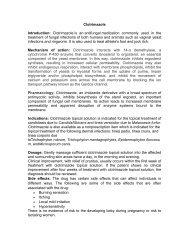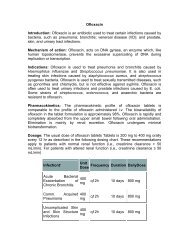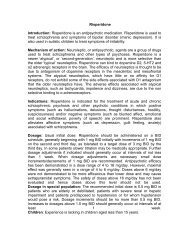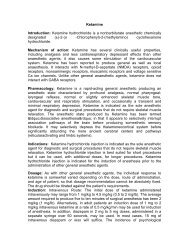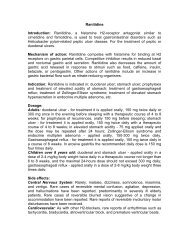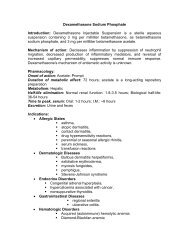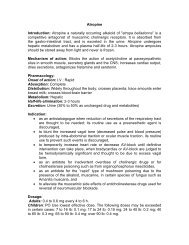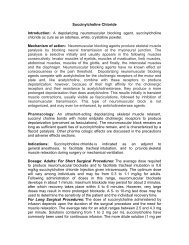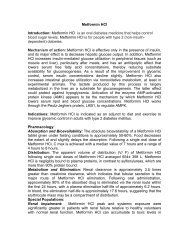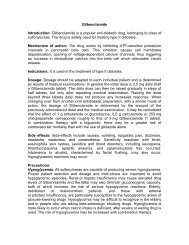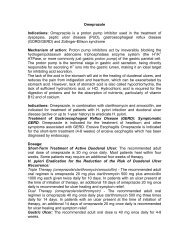Diclofenac sodium.pdf
Diclofenac sodium.pdf
Diclofenac sodium.pdf
Create successful ePaper yourself
Turn your PDF publications into a flip-book with our unique Google optimized e-Paper software.
<strong>Diclofenac</strong> <strong>sodium</strong><br />
Introduction: Nonsteroidal anti-inflammatory drugs used to relieve the<br />
inflammation, swelling, stiffness, and joint pain associated with rheumatoid<br />
arthritis, osteoarthritis<br />
Mechanism of action: The exact mechanism of action is not entirely known, but<br />
it is thought that the primary mechanism responsible for its anti-inflammatory /<br />
antipyretic / analgesic action is inhibition of prostaglandin synthesis by inhibition<br />
of cyclooxygenase (COX). Inhibition of COX also decreases prostaglandins in the<br />
epithelium of the stomach, making it more sensitive to corrosion by gastric acid.<br />
This is also the main side effect of diclofenac. <strong>Diclofenac</strong> has a low to moderate<br />
preference to block the COX2-isoenzyme (approximately 10-fold) and is said to<br />
have therefore a somewhat lower incidence of gastrointestinal complaints than<br />
noted with indomethacin and aspirin.<br />
Indications: <strong>Diclofenac</strong> <strong>sodium</strong> delayed-release tablets, are indicated:<br />
• For relief of signs and symptoms of osteoarthritis<br />
• For relief of signs and symptoms of rheumatoid arthritis<br />
• For acute or long-term use in the relief of signs and symptoms of<br />
ankylosing spondylitis<br />
Dosage:<br />
Osteoarthritis: The recommended dosage for maximal GI mucosal protection is<br />
diclofenac <strong>sodium</strong> 50 tid. For patients who experience intolerance, diclofenac<br />
<strong>sodium</strong> 75 bid or diclofenac <strong>sodium</strong> 50 bid can be used, but are less effective in<br />
preventing ulcers. This fixed combination product, diclofenac <strong>sodium</strong>, is not<br />
appropriate for patients who would not receive the appropriate dose of both<br />
ingredients. Doses of the components delivered with these regimens are as<br />
follows:<br />
OA<br />
regimen<br />
<strong>Diclofenac</strong><br />
<strong>sodium</strong><br />
(mg/day)<br />
Misoprostol<br />
(mcg/day)<br />
DICLOFENAC<br />
SODIUM 50<br />
tid<br />
bid<br />
150<br />
100<br />
600<br />
400<br />
DICLOFENAC<br />
SODIUM 75<br />
bid 150 400<br />
Rheumatoid Arthritis: The recommended dosage is diclofenac <strong>sodium</strong> 50 tid or<br />
qid. For patients who experience intolerance, diclofenac <strong>sodium</strong> 75 bid or<br />
diclofenac <strong>sodium</strong> 50 bid can be used, but are less effective in preventing ulcers.<br />
This fixed combination product, diclofenac <strong>sodium</strong>, is not appropriate for patients
who would not receive the appropriate dose of both ingredients. Doses of the<br />
components delivered with these regimens are as follows:<br />
RA<br />
regimen<br />
<strong>Diclofenac</strong><br />
<strong>sodium</strong><br />
(mg/day)<br />
Misoprostol<br />
(mcg/day)<br />
DICLOFENAC<br />
SODIUM 50<br />
qid<br />
tid<br />
bid<br />
200<br />
150<br />
100<br />
800<br />
600<br />
400<br />
DICLOFENAC<br />
SODIUM 75<br />
bid 150 400<br />
Side effects: Gastrointestinal experiences including: abdominal pain,<br />
constipation, diarrhea, dyspepsia, flatulence, gross bleeding/perforation,<br />
heartburn, nausea, GI ulcers (gastric/duodenal) and vomiting. Abnormal renal<br />
function, anemia, dizziness, edema, elevated liver enzymes, headaches,<br />
increased bleeding time, pruritus, rashes and tinnitus. fever, infection, sepsis,<br />
congestive heart failure, hypertension, tachycardia, syncope, dry mouth,<br />
esophagitis, gastric/peptic ulcers, gastritis, gastrointestinal bleeding, glossitis,<br />
hematemesis, hepatitis, jaundice, ecchymosis, eosinophilia, leukopenia, melena,<br />
purpura, rectal bleeding, stomatitis, thrombocytopenia, weight changes, anxiety,<br />
asthenia, confusion, depression, dream abnormalities, drowsiness, insomnia,<br />
malaise, nervousness, paresthesia, somnolence, tremors, vertigo, asthma,<br />
dyspnea, alopecia, photosensitivity, sweating increased, blurred vision, cystitis,<br />
dysuria, hematuria, interstitial nephritis, oliguria/polyuria, proteinuria, renal failure<br />
Precautions:<br />
General: <strong>Diclofenac</strong> <strong>sodium</strong> cannot be expected to substitute for corticosteroids<br />
or to treat corticosteroid insufficiency. Abrupt discontinuation of corticosteroids<br />
may lead to disease exacerbation. Patients on prolonged corticosteroid therapy<br />
should have their therapy tapered slowly if a decision is made to discontinue<br />
corticosteroids.<br />
Hematological Effects: Anemia is sometimes seen in patients receiving<br />
NSAIDs, including diclofenac <strong>sodium</strong>. This may be due to fluid retention, occult<br />
or gross GI blood loss, or an incompletely described effect upon erythropoiesis.<br />
Patients on long-term treatment with NSAIDs, including diclofenac <strong>sodium</strong>,<br />
should have their hemoglobin or hematocrit checked if they exhibit any signs or<br />
symptoms of anemia.<br />
Aseptic meningitis: As with other NSAIDs, aseptic meningitis with fever and<br />
coma has been observed on rare occasions in patients on diclofenac therapy.<br />
Although it is probably more likely to occur in patients with systemic lupus and<br />
related connective tissue diseases, it has been reported in patients who do not<br />
have an underlying chronic disease. If signs or symptoms of meningitis develop
in a patient on diclofenac, the possibility of its being related to diclofenac should<br />
be considered.<br />
Porphyria: The use of diclofenac <strong>sodium</strong> in patients with hepatic porphyria<br />
should be avoided.<br />
Nursing mothers: <strong>Diclofenac</strong> <strong>sodium</strong> has been found in the milk of nursing<br />
mothers. It is unlikely that misoprostol is excreted into milk since the drug is<br />
rapidly metabolized throughout the body.<br />
Pediatric use: Safety and effectiveness of diclofenac <strong>sodium</strong> in pediatric<br />
patients have not been established.<br />
Geriatric use: As with any NSAIDs, caution should be exercised in treating the<br />
elderly (65 years and older). <strong>Diclofenac</strong> is known to be substantially excreted by<br />
the kidney, and the risk of toxic reactions to diclofenac <strong>sodium</strong> may be greater in<br />
patients with impaired renal function. Because elderly patients are more likely to<br />
have decreased renal function, care should be taken in dose selection, and it<br />
may be useful to monitor renal function<br />
Contraindications: <strong>Diclofenac</strong> <strong>sodium</strong> is contraindicated in patients with<br />
hypersensitivity to diclofenac or to misoprostol or other prostaglandins.<br />
<strong>Diclofenac</strong> <strong>sodium</strong> should not be given to patients who have experienced<br />
asthma, urticaria, or other allergic-type reactions after taking aspirin or other<br />
NSAIDs. Severe, rarely fatal, anaphylactic-like reactions to diclofenac <strong>sodium</strong><br />
have been reported in such patients. <strong>Diclofenac</strong> <strong>sodium</strong> is contraindicated for the<br />
treatment of peri-operative pain in the setting of coronary artery bypass graft<br />
(CABG) surgery.<br />
How supplied: Customized as per request.



